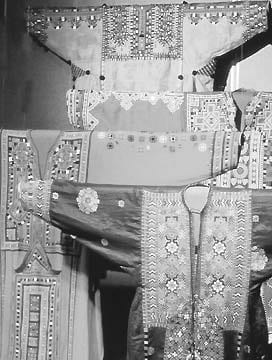Tana Bana: The Woven Soul of Pakistan
February 23 – April 27, 2003
Drawing upon private textile collections in Pakistan and Wisconsin, Tana Bana will feature more than 60 textiles and costumes from various cultures and regions of Pakistan. The exhibition is co-curated by Noorjehan Bilgrami, a textile historian and artist from Karachi, Pakistan, and Mary Ann Fitzgerald, curator of the University of Wisconsin’s Helen Louise Allen Textile Collection. This exhibition focuses on textile and costume traditions of the regions of Sindh, Punjab, the North-West Frontier Province and Baluchistan.
The province of Sindh in southeastern Pakistan has a rich heritage of textile embroidery, dyeing, block printing and weaving. Consequently the largest representation of textiles in the exhibition comes from Sindh. Many of the traditional block-printing, dyeing and weaving centers of Sindh are located near the Indus River, which supplies the water for washing, rinsing, and dyeing yarns and cloth.
The three types of textile production in the Punjab region highlighted in this exhibition include: silk weaving, phulkari embroidery and bandhani tie-dyeing. Tie-dyed cotton textiles called bandhani are produced for local markets in the Cholistan Desert region. The most distinguished embroidery from the Punjab is phulkari, which refers to both the embroidery technique and the textiles produced using this technique.
The North-West Frontier Province borders on Afghanistan and has been influenced by trade with Turkistan and China. Textile production in this area reflects the trade routes as well as the political strife created with the Soviet invasion of Afghanistan in 1979. Textiles are a mix of Afghani and Pakistani tradition with a focus on phulkari and other embroidery.
Baluchistan is the largest province in Pakistan and the least populated. Inhabited by four major nomadic and semi-nomadic ethnic groups, the textiles reflect their lifestyle of few [though intricately woven] possessions. The exhibition includes examples of bags, rugs and camel trappings, as well as clothing worn by the men and women of this region.
Many of the textile traditions represented in the exhibition extend to people and cultures beyond contemporary political boundaries. With the partition of India in 1947, the eastern boundary of Pakistan divided the Punjab and the regions of Jammu and Kashmir, and created a border through the Thar Desert of the Sindh, separating not only geographical areas but also common languages and cultural ties. The movement of people during partition also greatly impacted regional textile traditions. The western boundary of Pakistan, set during the 19th century, was determined by the struggle between Russia and Britain to establish geopolitical spheres of influence. The forces that shaped the current boundaries of Pakistan, therefore, do not necessarily reflect local traditions and history. Pakistan must be appreciated as a tremendous mingling of cultures and traditions, representing the diversity of South and Central Asia.
This exhibition is generously sponsored by the Pakistan Arts Council of USC Pacific Asia Museum and the Textile Group of Los Angeles/TGLA Inc.
Related Programs:
Members’ Exhibition Preview
Saturday, February 22, 1-5pm
The Textile Heritage of Pakistan
Sunday, February 23, 2pm
Exhibition curator, Noorjehan Bilgrami from Karachi, Pakistan will share her knowledge of South Asian textiles in a slide lecture exploring the rich textile traditions of Pakistan. She will examine weaving, dyeing, and embroidering techniques, textile ornamentation styles, and the diversity of forms seen in the textiles used for daily life and for special occasions. This lecture is offered free with Museum admission and is sponsored in part by the Textile Museum Associates of Southern California.
Textiles and Ornaments of the Ancient Indus Valley: 3rd Millenum to 3rd Century BC
Saturday, March 8, 2pm
This illustrated lecture with J. Mark Kenoyer, Associate Professor in the Department of Anthropology at University of Wisconsin-Madison, will look at the origins of textile production and ornament styles of the ancient Indus Valley civilization (2600-1900 BC). A short introduction to the earliest Neolithic cultures of Mehrgarh and the early Harappan culture at Harappa, will be followed by a more in-depth look at the evidence for cotton, wool and silk production in the ancient Indus cities. A brief discussion of the textile evidence from the early historic period will also be presented.
Companion Children’s Program
Saturday, March 8, 2-3pm
While their parents attend the lecture in the auditorium, children may participate in a hands-on workshop on Pakistan textile arts, which will be held in the courtyard. Children 7 years old and up may also participate in a tour of the exhibition, Tana Bana: The Woven Soul of Pakistan. The workshop will be led by members and volunteers of the Pakistan Arts Council of PAM, and the tour will be led by PAM tour guides.
Pakistan Festival Day: The Woven Soul of Pakistan
Saturday, April 19, 1-4pm
This free family event celebrates the ancient textile tradition of Pakistan. Activities include block-printing and tie-dying workshops for children, card-making workshop, traditional textile displays, and Pakistan food sampling. This event is free to the public. Sponsored in part by the Pakistan Arts Council.
